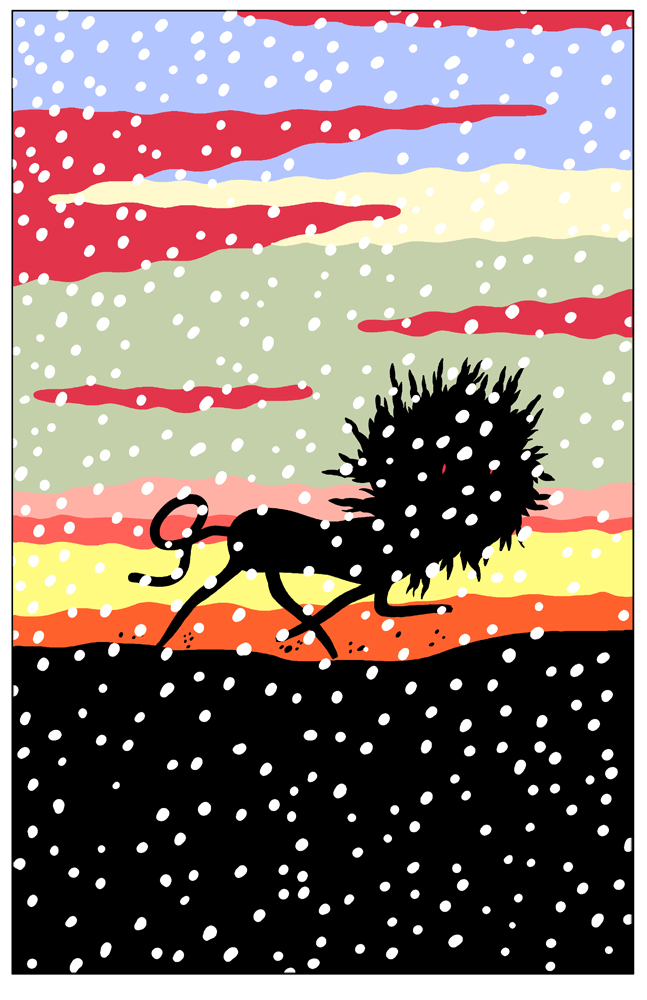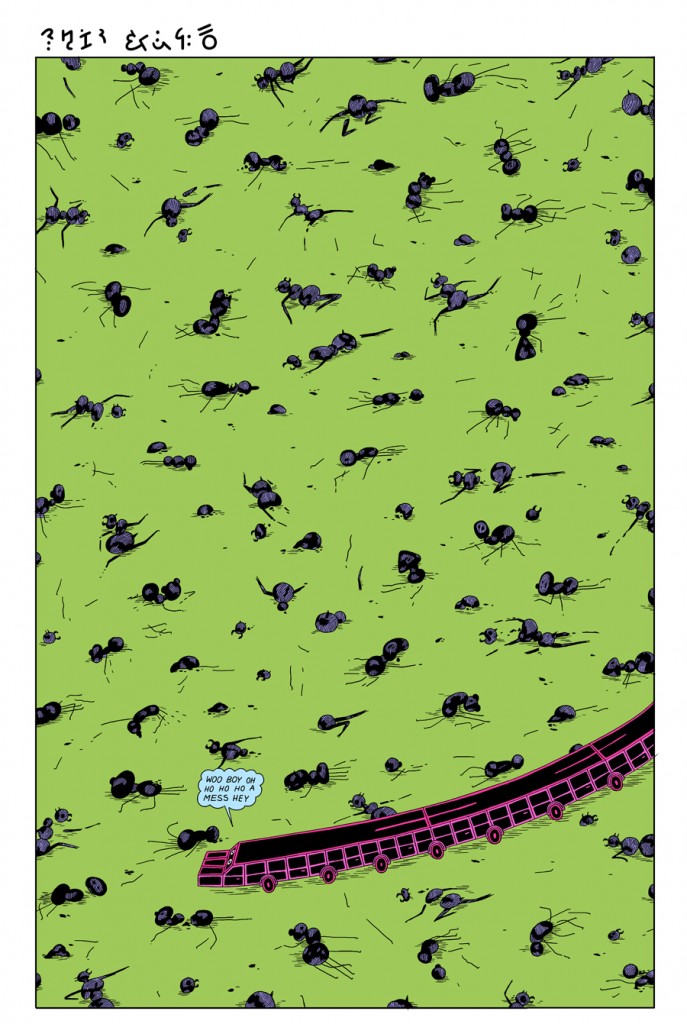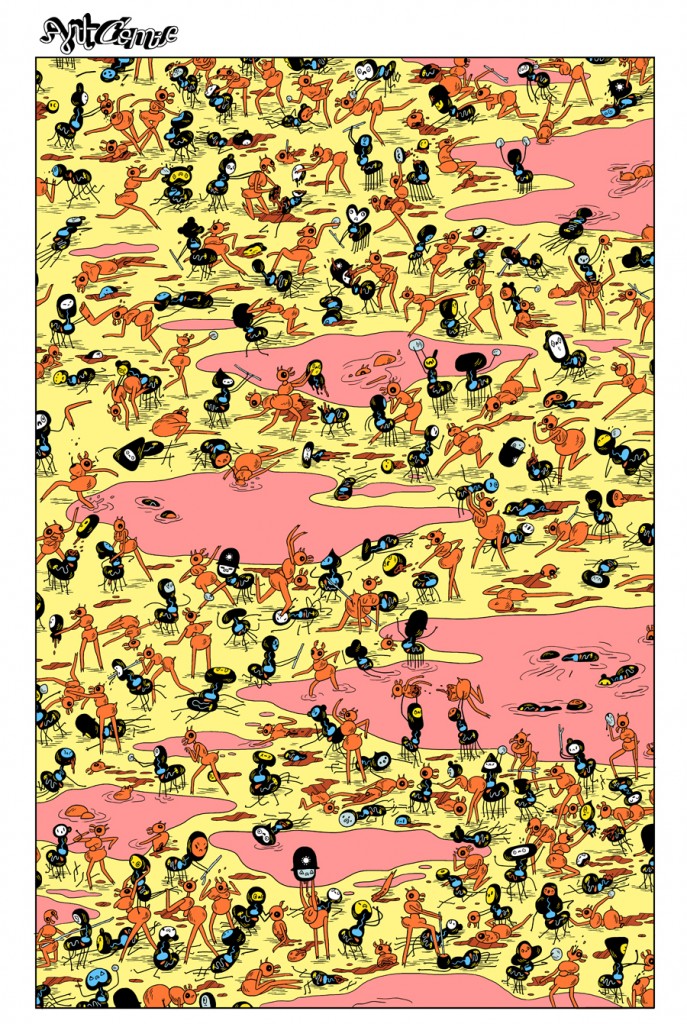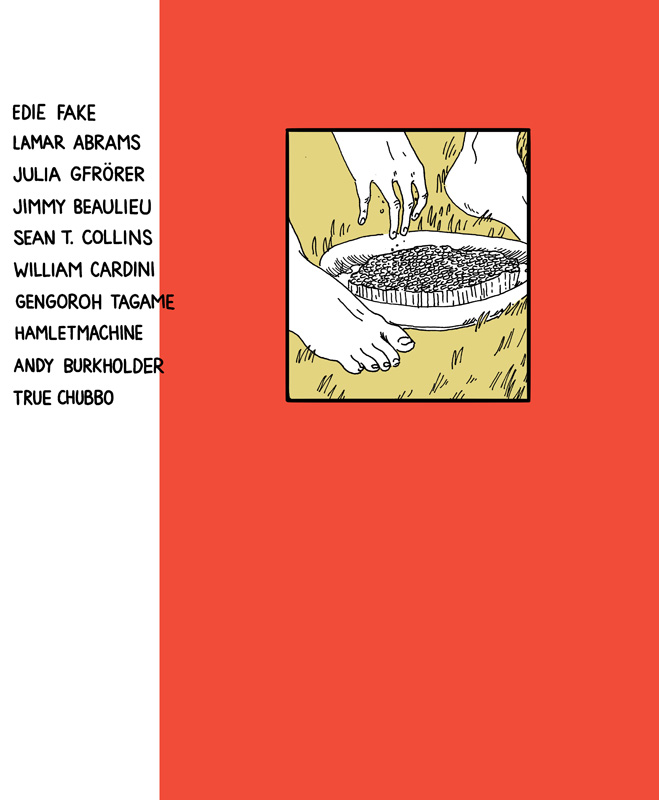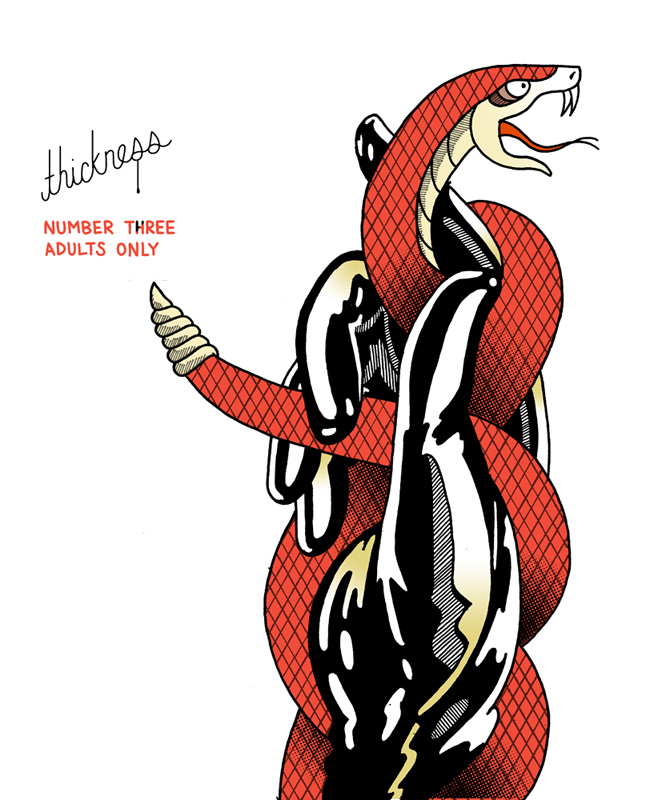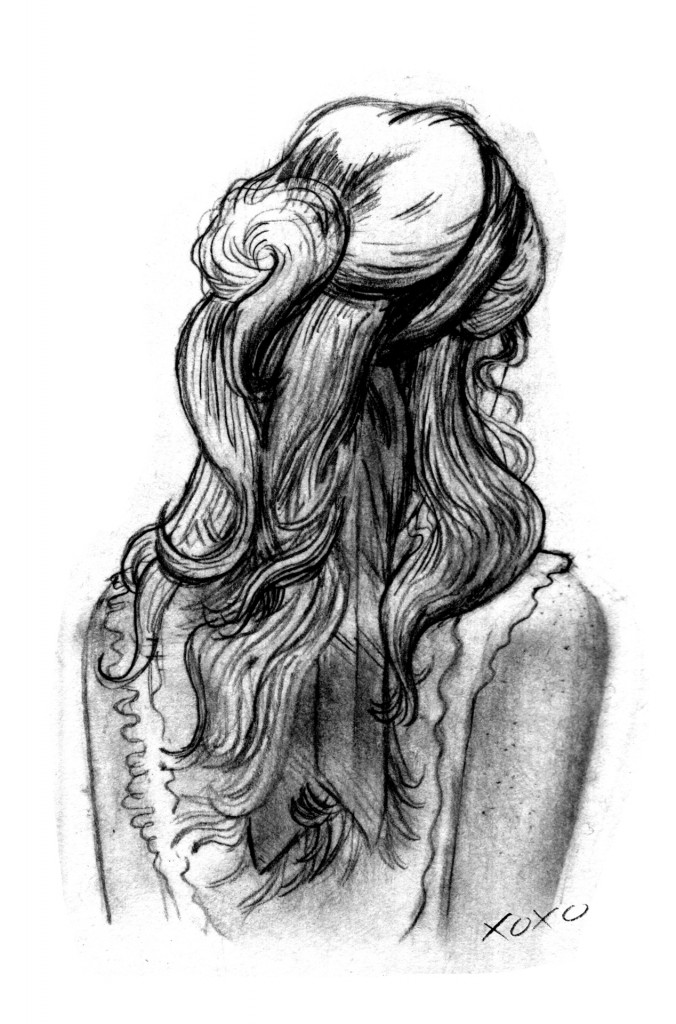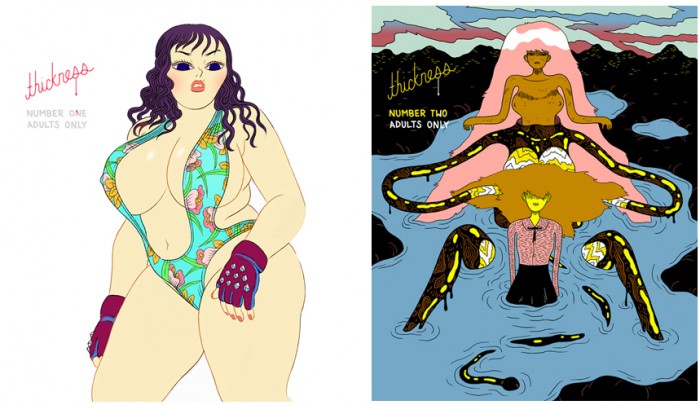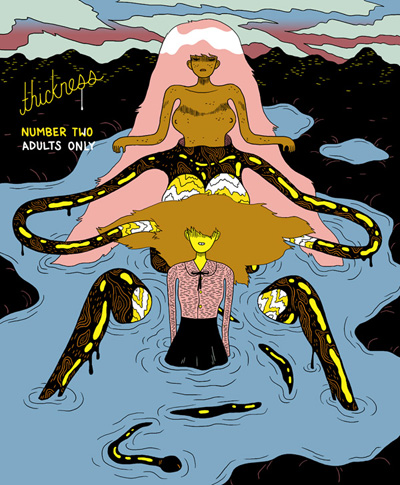Posts Tagged ‘Michael DeForge’
STC on DeForge in RS
January 19, 2015Comics Time: First Year Healthy
September 18, 2013Comics Time: Ant Comic
March 25, 2013I reviewed Michael DeForge’s masterful webcomic Ant Comic for The Comics Journal.
Please read the comic; it’s gorgeous, funny, troubling, and powerful, and you can read it all on a lovely single scrolling page.
Vorpalizer
February 6, 2013I’m going to be writing about science fiction, fantasy, horror etc. with some dayjob coworkers at our new group blog Vorpalizer.com. I got started with posts on Michael DeForge’s Ant Comic and Susan Cooper’s The Dark Is Rising. Come check it out.
Thickness #3: Back cover, bed of contents
June 6, 2012THICKNESS #3
30XX by Lamar Abrams
PROTESTPLOITATION by Jimmy Beaulieu
NIGHTCRAWLERS by Edie Fake
THE CHASM by Julia Gfrörer
THE COCKROACH by William Cardini & Sean T. Collins
STANDING OVATIONS by Gengoroh Tagame
QVIET by Andy Burkholder
…and a pinup by HamletMachine
(via Ryan Sands)
Love Me Like a Reptile/Feel My Serpentine
June 1, 2012Behold Edie Fake’s cover for Thickness #3, the erotic comics anthology featuring Edie Fake, Lamar Abrams, Julia Gfrörer, Jimmy Beaulieau, Sean T. Collins (yep, me!), William Cardini (who drew the thing I wrote), Gengoroh Tagame, Hamletmachine, Andy Burkholder, and True Chubbo, edited by Ryan Sands and Michael DeForge. Debuts at CAKE on June 16, available online everywhere shortly thereafter.
xoxo
May 24, 2012xoxo, a Gossip Girl zine
edited by Robin McConnell
cover by Maré Odomo
contributions by Warren Craghead, Sean T. Collins and Dan White, Benjamin Marra, Jacob Ferguson, Michael Deforge and Steve Rolston
Coming soon!
The full Thickness
April 29, 2012- Edie Fake
- Lamar Abrams
- Julia Gfrörer
- Jimmy Beaulieu
- Sean T. Collins / William Cardini
- Gengoroh Tagame
- A pinup by HamletMachine
- A new TRUE CHUBBO strip
- An Andy Burkholder mini supplemental
Turn me on, dead man!
Down with the Thickness
April 17, 2012I’m honored to announce that I’m collaborating with William Cardini on a story for Thickness #3, the forthcoming issue of Ryan Sands and Michael DeForge’s excellent and sexxy erotic comics anthology series. I just couldn’t be more humbled and pleased to be sharing such auspicious company in the service of that noblest of goals: using comics to increase the blood flow to people’s genitals. Wish us luck!
The 20 Best Comics of 2011
January 1, 201220. Uncanny X-Force (Rick Remender and Jerome Opeña, Marvel): In a year when the ugliness of the superhero comics business became harder than ever to ignore, it’s fitting that the best superhero comic is about the ugliness of being a superhero. Remender uses the inherent excess of the X-men’s most extreme team to tell a tale of how solving problems through violence in fact solves nothing at all. (It has this in common with most of the best superhero comics of the past decade: Morrison/Quitely/etc. New X-Men, Bendis/Maleev Daredevil, Brubaker/Epting/etc. Captain America, Mignola/Arcudi/Fegredo/Davis Hellboy/BPRD, Kirkman/Walker/Ottley Invincible, Lewis/Leon The Winter Men…) Opeña’s Euro-cosmic art and Dean White’s twilit color palette (the great unifier for fill-in artists on the title) could handle Remender’s apocalyptic continuity mining easily, but it was in silent reflection on the weight of all this death that they were truly uncanny.
19. The League of Extraordinary Gentlemen Vol. 3: Century #2: 1969 (Alan Moore and Kevin O’Neill, Top Shelf/Knockabout): I’ll admit I’m somewhat surprised to be listing this here; I’ve always enjoyed this last surviving outpost of Moore’s comics career but never thought I loved it. But in this installment, Moore and O’Neill’s intrepid heroes — who’ve previously overcome Professor Moriarty, Fu Manchu, and the Martian war machine — finally succumb to their own excesses and jealousies in Swinging London, allowing a sneering occult villain to tear them apart with almost casual ease. It’s nasty, ugly, and sad, and it’s sticking with me like Moore’s best work.
18. The comics of Lisa Hanawalt (various publishers): As I put it when I saw her drawing of some kind of tree-dwelling primate wearing a multicolored hat made of three human skulls stacked on top of one another, Lisa Hanawalt has a strange imagination. And it’s a totally unpredictable one, which is what makes her comics – whether they’re reasonably straightforward movie lampoons or the extravagantly bizarre sex comic she contributed to Michael DeForge and Ryan Sands’s Thickness anthology, as dark and damp as the soil in which its earthworm ingénue must live – a highlight of any given day a new one pops up.
17. Daybreak (Brian Ralph, Drawn and Quarterly): Fort Thunder’s single most accessible offspring also proves to be its bleakest, thanks to an extended collected edition that converts a rollicking first-person zombie/post-apocalypse thriller into a troubling meditation on the power of the gaze. Future artcomics takes on this subgenre have a high bar to clear.
16. Habibi (Craig Thompson, Pantheon): It’s undermined by its central characters, who exist mainly as a hanger on which this violent, erotic, conflicted, curious, complex, endlessly inventive coat of many colors is hung. But as a pure riot of creative energy from an artist unafraid to wrestle with his demons even if the demons end up winning in the end, Habibi lives up to its ambitions as a personal epic. You could dive into its shifting sands and come up with something different every time.
15. Ganges #4 (Kevin Huizenga, Coconino/Fantagraphics): Huizenga wrings a second great book out of his everyman character’s insomnia. It’s quite simple how, really: He makes comics about things you’d never thought comics could be about, by doing things you never thought comics could do to show you them. Best of all, there’s still the sense that his best work is ahead of him, waiting like dawn in the distance.
14. The Congress of the Animals (Jim Woodring, Fantagraphics): The potential for change explored by the hapless Manhog in last year’s Weathercraft is actualized by the meandering mischief-maker Frank this time around. While I didn’t quite connect with Frank’s travails as deeply as I did with Manhog’s, the payoff still feels like a weight has been lifted from Woodring’s strange world, while the route he takes to get there is illustrated so beautifully it’s almost superhuman. It’s the happy ending he’s spent most of his career earning.
13. Mister Wonderful (Daniel Clowes, Pantheon): Speaking of happy endings an altcomix luminary has spent most of his career earning! Clowes’s contribution to the late, largely unlamented Funny Pages section of The New York Times Magazine is briefly expanded and thoroughly improved in this collected edition. Clowes reformats the broadsheet pages into landscape strips, eases off the punchlines and cliffhangers, blows individual images up to heretofore unseen scales, and walks us through a self-sabotaging doofus’s shitty night into a brighter tomorrow.
12. The comics of Gabrielle Bell (various publishers): Bell is mastering the autobiography genre; her deadpan character designs and body language make everything she says so easy to buy – not that that would be a challenge with comics as insightful as her journey into nerd culture’s beating heart, San Diego Diary, just by way of a for instance. But she’s also reinventing the autobiography genre, by sliding seamlessly into fictionalized distortions of it; her black-strewn images give a somber, thoughtful weight to any flight of fancy she throws at us. What a performance, all year long.
11. The Armed Garden and Other Stories (David B., Fantagraphics): Religious fundamentalism is a dreary, oppressive constant in its ability to bend sexuality to mania and hammer lives into weapons devoted to killing. But it has worn a thousand faces in a millennia-long carnevale procession of war and weirdness, and David B. paints portraits of three of its masks with bloody brilliance. Focusing on long-forgotten heresies and treating the most outlandish legends about them as fact, B.’s high-contrast linework sets them all alight with their own incandescent madness.
10. Too Dark to See (Julia Gfrörer, Thuban Press): It was a dark year for comics, at least for the comics that moved me the most. And no one harnessed that darkness to relatable, emotional effect better than Julia Gfrörer. Her very contemporary take on the legend of the succubus was frank and explicit in its treatment of sexuality, rigorously well-observed in its cataloguing of the spirit-sapping modern-day indignities that can feed depression and destroy relationships, and delicately, almost tenderly drawn. It’s like she held her finger to the air, sensed all the things that can make life rotten, and cast them onto the pages. She made something quite beautiful out of all that ugly.
9. The comics and pixel art of Uno Moralez (self-published on the web at unomoralez.com): What if an 8-bit NES cut-scene could kill? The digital artwork of Uno Moralez — some of it standard illustrations, some of it animated gifs, some of it full-fledged comics — shares its aesthetic with The Ring‘s videotape or Al Columbia’s Pim & Francie: a horror so cosmically black, images so unbearably wrong, that they appear to have leaked into and corrupted their very medium of transmission. Moralez fuses crosses the streams of supernatural trash from a variety of cultures — the legends and Soviet art of his native Russia, the horror and porn manga of Japan, the B-movies and horror stories of the States, the formless sensation aesthetic of the Internet itself — into a series of images that is impossible to predict in its weirdness but totally unflagging in its sense that you’d be better off if you’d never laid eyes on it. I can’t wait to see more.
8. The comics of Michael DeForge (various publishers): The last time you saw a cartoonist this good and this unique this young, you were probably reading the UT Austin student newspaper comics section and stumbling across a guy named Chris Ware. All four of DeForge’s best-ever comics — his divorced dad story in Lose #3, his shape-shifting/gender-bending erotica in Thickness #2, his self-published art-world fantasia Open Country, and his gorgeously colored body-horror webcomic Ant Comic — came out this year, none of them looking anything at all like anything you could picture before seeing your first Michael DeForge comic. It’s almost frightening to think where he’ll be five years from now, ten years from now…or even just this time next year.
7. The comics and art of Jonny Negron (various publishers): What if someone took Christina Hendricks’s walk across the parking lot and trip to the bathroom in Drive and made an entire comics career out of them? That is an enormously facile and reductive way to describe the disturbing, stylish, sexy, singular work of Jonny Negron, the breakout cartoonist of the year, but it at least points you in the right direction. No one’s ever thought to combine his muscular yet curiously dispassionate bullet-time approach to action and violence, his Yokoyama-esque spatial geometry, his attention to retrofuturistic fashion and style, his obvious love of the female body in all its shapes and sizes, and his ambient Lynchian terror; even if they had, it’d be tough to conceive of anyone building up his remarkable body of work in such a short period of time. Open up your Tumblr dashboard or crack an anthology (Thickness, Mould Map, Study Group, Smoke Signal, Negron and Jesse Balmer’s own Chameleon), and chances are good that Negron was the weirdest, best, most coldly beautiful thing in it. It’s like a raw, pure transmission from a fascinating brain.
6. The Wolf (Tom Neely, I Will Destroy You): Neely’s wordless, painted, at-times pornographic graphic novel feels like the successful final draft to various other prestigious projects’ false starts. It’s a far less didactic, more genuinely erotic attempt at high-art smut than Dave McKean’s Celluloid; a less self-conscious, more direct attempt at frankly depicting both the destructive and creative effects of sex on a relationship via symbolism than Craig Thompson’s Habibi; a blend of sex and horror and narrative and visual poetry and ugly shit and a happy ending that succeeds in each of these things where many comics choose to focus on only one or two.
5. The Cardboard Valise (Ben Katchor, Pantheon): Prep your time capsules, folks: You’d be hard pressed to find an artifact that better conveys our national predicament than Ben Katchor’s latest comic-strip collection, a series of intertwined vignettes created largely before the Great Recession and our political class’s utter failure to adequately address it, but which nonetheless appears to anticipate it. Its message — that blind nationalism is the prestige of the magic trick used by hucksters to financially and culturally ruin societies for their own profit — is delightfully easy to miss amid Katchor’s remarkable depictions of lost fads, trends, jobs, tourist attractions, and other detritus of the dying American Century. He’s the very most funnest Cassandra around.
4. Love from the Shadows (Gilbert Hernandez, Fantagraphics): I picture Gilbert Hernandez approaching his drawing board these days like Lawrence of Arabia approaching a Turkish convoy: “NO PRISONERS! NO PRISONERS!” In a year suffused with comics funneling pitch-black darkness through a combination of sex and horror, none were blacker, sexier, or more horrific than this gender-bending exploitation flick from Beto’s “Fritz-verse.” None also functioned as a rejection of the work that made its creator famous like this one did, either. Not a crowd-pleaser like his brother, but every bit as brilliant, every bit as fearless.
3. Garden (Yuichi Yokoyama, PictureBox): Like a theme park ride in comics form — with the strange events it chronicles themselves resembling a theme park ride — Yokoyama’s book is a breathtaking, breathless experience. Alongside his anonymous but extravagantly costumed non-characters, we simply go along for the ride, exploring Yokoyama’s prodigious, mysterious imagination as he concocts a seemingly endless stream of increasingly strange interfaces between man and machine, nature and artifice. As a metaphor for our increasingly out-of-control modern life it’s tough to top. As pure thrilling kinetic cartooning it’s equally tough to top.
2. Big Questions (Anders Nilsen, Drawn & Quarterly): Last year, I wrote that if the collected edition of Nilsen’s long-running parable of philosophically minded birds and the plane crash that turns their lives upside-down didn’t top my list whenever it came out, it must have been some kind of miracle year. Turns out that it was. But you’d pretty much have to create a flawless capstone to a thirty-year storyline of neer-peerless intelligence and artistry to top this colossal achievement. Nilsen’s painstaking, pointillist cartooning and ruthless examination of just how little regard the workings of the world have for any given life, human or otherwise, marks him as the best comics artist of his generation, and solidifies Big Questions‘ claim as the finest “funny animal” comic since Maus.
1. Love and Rockets: New Stories #4 (Gilbert and Jaime Hernandez, Fantagraphics): Gilbert got his due elsewhere on my list, so let’s ignore his contribution to this issue, which advance the saga of his bosomy, frequently abused protagonist Fritz Martinez both on and off the sleazy silver screen. Instead, let’s add to the chorus praising Jaime’s “The Love Bunglers” as one of the greatest comics of all time, the point toward which one of the greatest comics series of all time has been hurtling for thirty years. In a single two-page spread Jaime nearly crushes both his lovable, walking-disaster main characters Maggie and Ray with the accumulated weight of all their decades of life, before emerging from beneath it like Spider-Man pushing up from out of that Ditko machinery. You can count the number of cartoonists able to wed style to substance, form to function, this seamlessly on one hand with fingers to spare. A masterpiece.
Comics Time: Thickness #2
October 17, 2011Thickness #2
Angie Wang, Lisa Hanawalt, Michael DeForge, Mickey Zacchilli, Brandon Graham, True Chubbo, Jillian Tamaki, writers/artists
Ryan Sands and Michael DeForge, editors
self-published, October 2011
60 pages
$12
Buy it from the Thickness website
Anthology of the year? I’d need to double-check some release dates, but it certainly seems that way to me. The second installment of Ryan Sands and Michael DeForge’s art-smut comics series is an intense, diverse collection of sex comics, beautifully printed and rich enough to revisit well after your first virgin read.
Michael DeForge, god help us all, continues his juggernaut run with what could well be his best comic yet. “College Girl by Night” stars a young man who’s transformed by the light of the full moon into a beautiful young woman, and uses the time to seduce and fuck college boys. His/her narrative captions don’t comment on the night-in-the-life activities depicted in the art, but rather explain the background of the transformations, her preferred conquests (tired of her “spoiled, drunken nineteen-year-olds,” she’s “made vague plans to set my sights on Edgeton professors, posing a student seeking advice after hours”), her almost idle questions about the science of it all (“Maybe if I got pregnant, it would only show when I transformed. If I even have a uterus, that is”), fictional precedents (“When Billy changed into Captain Marvel he wasn’t technically ‘transforming’…he was having his Billy Batson body physically replaced with an entirely different Captain Marvel one”), and daydreams about starting a relationship while in female form (“I once found a Missed Connection written about me on Craigslist”). It’s funny stuff, featuring DeForge’s trademark juxtaposition of the fantastic and the mundane. But it’s also really, really hot stuff. His character design for the main character’s female form is a note-perfect assemblage of alluring details: spagetti-like tendrils of hair, a dusting of freckles, a short and nearly translucent dress, long lashes that flutter when she throws her mouth open in ecstasy. But then DeForge takes the ruthlessly (if ironically) heterosexual nature of the situation (as she herself puts it, “Is it hugely unimaginative that during my time as a woman, the only activities I’ve done so far is fuck myself or get fucked?”) and crashes it right into its own subtext, reversing the transformation mid-coitus and presenting the two college guys now present on the scene with the opportunity to pick up where they left off, or not. Even if your door doesn’t swing in that direction, there’s a willingness to be led solely by pleasure and desire, a “Shhhh–no one can see, so why not?” quality, that’s hard to deny.
Brandon Graham’s “Dirty Deeds” is the most lighthearted of the contributions (well, aside from True Chubbo’s), and his sense of humor isn’t mine. It’s got this bigfooted vaudevillian underground schtickiness to it that’s just not my thing unless it’s Marc Bell. (Lots and lots of puns: “prostate of shock,” “cervix with a smile,” “I was young, I needed the monkey” — that last one’s a bit of a long story.) But that’s not to say that a breezy sex romp isn’t a welcome addition to this issue’s 31 flavors. Certainly Graham’s warm, curving line is shiny and happy enough to make up for a few jokes that leave me cold, and it’s fascinating watching him use it to achieve certain unique effects — the way he crams detail into limited segments of the page, piling line on line like a soft-serve ice cream cone, while letting the rest of the page breathe, say, which in turn lets him work wonders with images of massive science-fictional scale. And he really makes the most of Sands’s red-orange risograph’d coloring, particularly with his vivacious heroine’s hair and a sexy tan-line effect using what looks like the world’s tiniest zipatone dots. I’m kind of amazed that anything would give this Adrian Tomine print a run for its money in the “Sexiest Use of Tanlines 2011” sweepstakes, but there you have it.
Mickey Zacchilli’s contribution is the most off-model of the bunch, a melancholy affair in which a Brian Chippendalesque lost girl loses her wedding ring and therefore enters some weird subterranean sex chamber, in which a brawny beast and a “slime worm” have their way with her as she worries about other things. What keeps her going is the promise of ice cream on the other side of the chamber, but the showstopping reverie begins with the phrase “All I could think about at that moment were all the various objects that I had never stuck in my vagina.” Arrayed in the closest thing to a clinical grid as Zacchilli’s noisy, scratchy line can muster, this assortment goes from “Yeah, okay, feasible for a curious young woman” (“screwdriver,” “chisel tip Sharpie permanent marker”) to “uh-oh” (“rawhide dog bone,” “rotting arm,” “disembodied head”). When added to the brusque treatment she receives from the creature who lets her in — “Thru the door Alice, Jeanette, Angie, whatever” he says, her identity unimportant — and her tears when she discovers the ice cream shop is closed, it makes for a distressing portrait of disconnect between mind and body, thought and deed.
Dare I call Angie Wang’s contribution erotica rather than smut? Wang offers a four-page start-to-finish portrait of two women — one seemingly shy or hesitant, the other taking charge — having sex. Each panel depicts a discrete body part or moment of connection. It’s a familiar panoptic effect for this kind of thing, and I usually find it to be a bit false to the experience of sex, presenting it as a sort of greatest-hits grab bag rather than a journey from start to finish where the momentum, the upping of the ante from moment to moment, is key. But Wang cleverly jettisons the mishmash approach with an array of techniques: ratcheting the panel grid back from page to page, from 16 to 9 to 4 to a final, climactic (pun intended) splash page; using tangents to connect one panel to the next; paring away dialogue and sound as she goes; altering the focus of each page, from foreplay to initial genital contact to climax to afterglow. Whether despite or because of its delicate, painterly line, it’s got oomph.
Lisa Hanawalt’s contribution is profoundly Hanawaltian. Using the tried-and-true porn setup of the teacher with the hot student, she subverts (or heightens, depending on what you’re into) the fantasy by having the pair’s taboo rendez-vous take place in full view of the rest of the class; the teacher doesn’t even stop delivering his lesson on unreliable narrators (“the narrator makes mistakes” he says as he unzips his fly). Hanawalt apes the male focus on individual body parts with alarming accuracy: “Oh god, her tits! Tiiiiiits…And that ASS,” thinks the teacher over a series of panels focusing on the student’s curves with that familiar combination of thumbs-up celebration and lizard-brain leer. Oh, did I mention she short-circuits the whole thing by giving the girl the featureless conical head of a worm while stuffing her cleavage with fibrous miniature worms, and by giving the bird-headed teacher a penis that itself ends in a bird’s head, which literally vomits its semen all over her ass and vagina when he pulls out? When she slaps a David Lee Roth-referencing “CLASS DISMISSED!” on the final panel, I’m not sure whether to run for the door or stay for extra credit.
The final two contributions hearken back to Sands’s zine roots: Ray Sohn and his anonymous wife serve up one of the funniest, grossest True Chubbo strips to date (you’ll love the Lawrence of Arabia “NO PRISONERS!” quote, especially once you see the context in which it’s being quoted), while Jillian Tamaki’s centerfold pinup intrigues with its incongruous details — a monumental topless woman kneels amid lush flowers and a small army of Russian doll-like people-shaped dildos (I think?), her implacable gaze juxtaposed with her very human bikini-area stubble and a big goofy digital watch on her wrist. They give Thickness #2 a welcome diversity of form as well as content, a “hey, here’s everything that was fit to print” feel.
Thickness #2 is the real deal: talented, fearless cartoonists working in that viscous red zone of pleasure, terror, filth, and fun where the only thing that matters is what the body does and doesn’t want, and your brain is simply forced to go along for the ride. Bravo, thumbs up, panties down.
Comics Time: Prison for Bitches
June 10, 2011Prison for Bitches
Ryan Sands, Hellen Jo, Calivn Wong, Anthony Ha, Makkinoso, Gea, Sophia Foster-Dimino, Chris Kuzma, Johnny Ryan, Sophie Yanow, Chris “Elio” Eliopoulos, Michael Kupperman, Adam Bronson, An Nguyen, Mickey Zacchilli, Lisa Hanawalt, Anthony Wu, Evan Hadyen, Leslie Predy, Monika Uchiyama, y16o, Ryan Germick, Saicoink, Angie Wang, Tony Tulathimutte, Andre Syzmanowicz, Raymond Sohn, Michael DeForge, Mia Shwartz, Patrick Kyle, Derek Yu, Jordyn Bochon, Seibei, Ginette Lapalme, Nick Gazin, Harvey James, Zejian Shen, Robert Dayton, Aaron Mew, writers/artists
Ryan Sands and Michael DeForge, editors
self-published, 2010
64 pages
$12
Buy it and see an extensive preview at PrisonForBitches.com
The wonderful thing about recruiting a galaxy of underground comics and illustration stars to make a Lady Gaga fanzine is that no matter what kind of extravagant weirdness they concoct, there’s a better-than-even chance that at any moment the Lady herself could come along and comfortably out-weird them all. Nearly to a piece, the art, comics, photography, interviews, and essays assembled here by the Thickness team of Ryan Sands and Michael DeForge appear to have been created with a healthy appreciation for their own potential obsolescence in mind, and admiration and awe for the relentlessly and exuberantly creative young woman who’d make it happen. How else to explain the number of contributions that portray Gaga as godlike? In the hands of the Prison for Bitches team, Gaga is a queen seated on a giant telephone throwing trinkets to the huddled masses (Foster-Dimino); a vision appearing in dreams to espouse Anarcho-Gagaism to her supplicants (Yanow); a Big Brother-style disembodied head whose kohl-rimmed eyes stare at the viewer with a totalitarian sex-death gaze like something out of Metropolis (Kupperman); a She-Ra/ELA-esque figure riding through space atop a crystalline Battle-cat (Hayden); a Ray-Ban-wearing Baphomet (Predy); a giant sea goddess towering over the bodies of the drowned (Wang); an empress who lives to be 110 years old (DeForge); a severed head whose tongue, hair, and blood vessels are Cthulhoid tentacles (Aaron Mew). She is seen as supernatural, both a Delphic oracle of fabulousness and a Ring-claiming Galadriel proclaiming “All shall love me and despair.”
On the “love me” point, only a handful of the contributors work with the fact that she’s a very attractive person, but they’re among my favorites: André Syzmanowicz lovingly depicts the curves of her stomach, her breasts, her armpits, even as a werewolf creature gropes her from behind; a strip from Robert Dayton sees an ostensible fan complain about her mediocre music and ripped-off style, finally responding to the question “What do you like about her then?” with “Her navel—I want to lick her navel”; and right between the staples in the centerfold spread that anchors the book’s central full-color section, Mickey Zacchilli sticks the singer’s famously fit rear end.
Still other contributors take advantage of Gaga’s graphic potential for maximum maximalist imagemaking — artist after artist (Jo, Wang, Gazin, Yu, Bochon, Foster-Dimino) have a ton of fun with her hair, culminating in a spectacular caricature of her Coke-can curlers from the “Telephone” video by Harvey James. An Nguyen and the team of Hellen Jo & Calvin Wong provide concert reportage, the former with photos of her cosplaying fans, the latter with comics about the on- and off-stage spectacle of the concert experience.
A trio of prose pieces appear in what seems like ascending order of skepticism; in descending order, Adam Bronson has a funny piece that uses Deleuze and Hegel to analyze the relative potential of Gaga’s “Let’s Dance” and Frank Sinatra’s “My Way” to provoke violence in Filipino karaoke bars; Anthony Ha interviews Vanessa Grigoriadis, author of New York magazine’s seminal profile of Gaga’s origins and rise to fame, that’s best summed up by its title – “I’m a Total Fan of Hers, I Just Am Not a Huge Fan of Her Music”; editor Sands kicks the whole thing off with an utterly sincere and descriptively, persuasively argued “UNDISPUTED TOP 5 LADY GAGA SONGS,” featuring genuine gems like “[‘Alejandro’] sounds like ABBA’s ‘Fernando’ rubbing lotion all over Ace of Base’s ‘Don’t Turn Around’ while bathing nude on ‘La Isla Bonita'” and “[‘So Happy I Could Die’ is] really just a simple song about being convinced you are the hottest and most desirable person on the earth, and that this can be the best of all possible worlds if we allow ourselves the pleasure.” Taken in tandem, they’re like a debate between different modes of Gaga fandom, from arch irony to measured respect for a pop-culture needle-mover to downright love for someone who makes awesome songs to dance to.
The whole zine works like this, basically. Whatever it is you get out of Gaga — a pop-art deity, a gorgeous girl, an eye-inspiring spectacle, a thinkpiece generator, a hitmaker — by all means share that fun with a world that doesn’t have enough of it. This book is a snapshot of the Gaga conversation, post-“Telephone” video 2010; it’s a testament to the contributors and their subject alike that even now that the specifics of that conversation have now been rendered moot by an album full of pinball music and Clarence Clemons sax solos with a cover that reads “BORN THIS WAY” over a picture of the artist as a motorcycle with a human head, I’d love to hear them have it all over again. Prison for Bitches is a Little Monster must-have for any Gaga fan.
Comics Time: Thickness #1
June 8, 2011Thickness #1
Katie Skelly, Jonny Negron, Zejian Shen, Derek Ballard, True Chubbo, writers/artists
Ryan Sands and Michael DeForge, editors
self-published, May 2011
48 pages
$12
Buy it from the Thickness website
The great altcomix fuckfest continues! Of the recent releases I’ve read that pass smut through the same art-comics filter that science fiction, fantasy, action, and horror have all recently traversed, Thickness is the book that seems most concerned with creating out-and-out pornography. Chalk that up primarily to the anthology’s centerpiece and unquestionable standout, “Grandaddy Purple, Erotic Gameshow,” by cover artist Jonny Negron. “Dreamlike” is an adjective that gets tossed around a lot, by me not least of all, but that’s absolutely the right way to describe the plot of this thing, which starts with two sinister gangster-type figures falling victim to a rooftop assassination, then follows the assassin as he’s rewarded with a Let’s Make a Deal selection of prizes hidden behind three numbered doors, then shows him claiming his prize — a beautiful woman — in explicit detail, and ends with his post-climax black-widow murder. Negron can’t seem to contain his glee during the sex scene: The woman shouts out no-fuckin’-around, let’s-have-fun-with-our-bathing-suit-area exclamations like “Mmm, let’s see how much I can fit in my mouth!” and “Fuck! We’re goin’ to have fun with this cock!”, while Negron frequently breaks down his large panels into sub-grids of as many as nine, 10, or 11 panels, using the layout language of Acme Novelty Library to cram in as many of the deliciously dirty details of the characters’ liaison as possible before running out of room on the page. To quote Maude Lebowski, sex in Negron’s hands is a zesty enterprise. But it’s just one of the arrows in his quiver: His story also features angular artificial environments and M.U.S.C.L.E.S.-style character designs that, when combined with his women’s King magazine physiques and his bad guys’ skinny-suit-and-shades-sporting comportment, makes him come across like a happy marriage of Yuichi Yokoyama and Benjamin Marra. His depiction of action is really a marvel, too: It can be dynamically staged as all get-out, but then he does something off-kilter, like showing a falling man’s impact with the floor and his subsequent post-mortem prostration in a fashion that totally flattens the moment, calls attention to its ludicrousness, and yet somehow makes it feel all the more brutal and unpleasant for that. Ditto the final image, which I won’t spoil.
By comparison the other contributions can’t help but feel slight. Katie Skelly’s “cute-sexy floppy-eared lady has sex with plants in a sci-fi paradise that suggests Vaughan Bode mated with Georgia O’Keefe” entry “Breeding Season” is covering well-worn territory for SF erotica, though her thick rounded inks are nice to look at and she has a knack for capturing certain visual details that entice, like the gap between the fabric of the heroine’s suspender-like bathing suit and her breast and torso when viewed from the side. Zejian Shen’s “Pearl Divers” wrings an amusing dual joke out of its title’s double entendre by anthorpomorphizing both the oysters captured by the titular fisherwomen and their clitorises as they celebrate their catch with some beachside tribadism. Derek Ballard’s “Trap Shadez” is another sci-fi story whose sexual content is actually relatively minimal; for my taste it overelies on angular ’80s-tinged figurework and design that can’t quite overcome storytelling that’s deliberately but still unsuccessfully unclear. The True Chubbo comic that closes out the collection is a solid example of that strip’s unusual charm (it’s more charming than funny), wherein the love between creators Ray Sohn and his anonymous wife comes through all the clearer the worse their ridiculously violent sexual violations of one another get. Sands and DeForge’s high-quality production, including risograph printing that gives each story a fitting primary color ink, certainly elevates each contributor — the murky purple selected for Negron makes that particular freakout even seedier, somehow. He’s worth the price of admission all by himself, and hey, a home run after four singles still puts a lot of runs on the scoreboard.
Comics Time: Open Country #1
June 1, 2011Open Country #1
Michael DeForge, writer/artist
self-published, May 2011
16 pages
Read some preview pages, and buy it eventually, I’d imagine, at Michael DeForge’s website
I think there’s a greatest-hits compilation called A Young Person’s Guide to King Crimson? That’s sort of what this is for Michael DeForge. Nearly all his themes can be heard here: deadpan slice-of-life dialogue juxtaposed with extravagantly odd SFF concepts; deconstructed, dismantled, dismembered, disfigured human bodies and faces, like cubism reimagined as body horror; friendship depicted primarily as a venue for venting ideas and concerns at one another rather than real emotional interaction; uncomfortably accurate and funny lampooning of the disconnect between lofty art-school philosophizing and post-graduation economic reality; visually spectacular treatment of altered states shared by two people; creepy horror slowly oozing out of and eventually overwhelming previously established ideas. Conspicuously absent are the full-fledged rubble-strewn wastelands of the sort seen in Lose #3, but in their place there’s a conversation about such post-apocalyptic landscapes. It comes in the context of an interview with the visual artist whose work is the catalyst for the comic. She works in the medium of psychic projection, said by our leading man to be the province of the educated and access-granted elite: “Sometimes I wish I had actually stayed in art school so I could have learned how to do that sort of thing. There are so many techinques that I don’t have the time or resources to learn on my own…psychic projection, silkscreening, linocuts, darkroom photography–all that stuff.” Our hero tries to bone up on the form by watching an interview with the artist (whom we first see as she projects an avatar of herself that’s gigantic, nude, impaled in a field of debris, and begging for help) on YouTube: “[Do you] really believe that? That there’s ‘nothing left to build on?'” asks her interviewer. “Your imagery is so preoccupied with debris, clutter, refuse…'” This might as well be an interview with DeForge himself. And like a good interview, Open Country #1 is a great thing to hand someone who wants to see what’s up with the artist in question.
Comics Time: Lose #3
May 18, 2011 Lose #3
Lose #3
Michael DeForge, writer/artist
Koyama Press, May 2011
pages
$5
Buy it from Michael DeForge
It’s one thing to take a Chris Ware/Daniel Clowes middle-aged sad-sack comedy of discomfort and plop it into a slime-encrusted anthropomorphized-mutant-animal-inhabited post-apocalyptic hellscape that looks like Jon Vermilyea staging a Teenage Mutant Ninja Turtles revival in the middle of Cormac McCarthy’s The Road. It’s quite another thing to do this well. And it’s still another thing to do it so well that while the whole is indeed more than the sum of its parts, the parts work all on their own, too. That’s the achievement of Lose #3, the latest installment in Michael DeForge’s old-school one-man alternative comic series.
In past issues, as well as in his minis and anthology contributions, DeForge has proven adept at crafting razor-sharp embodiments/lampoons of what have been termed “first world problems” and placing them in the mouths of fantastical, outlandishly designed and drawn creatures and monsters and superheroes and giant mecha and what have you. (“I feel like things have been weird between us lately,” reads the image of the shaggy faceless beast rolling around on the ground — that sort of thing.) And he does that here, too, to cringingly devastating effect: The text for the opening one-pager is a letter from a fresh-faced intern high on his first trip to NYC to his mother back home (“I asked if there were any paid positions opening at the magazine in the fall. They said things were still up in the air for now. Fingers crossed, I suppose!”), juxtaposed against the images of a naked man riding a spotted deer through a debris-strewn wasteland in order to pour the coffee he purchases at a still-standing chain coffee house into the maw of the creature that lives in his cave. Toward the end of the collection, ants wax pessimistic about life in these weird, dark times (“But, like — why do we live this way? It’s — it’s nuts that this is the ‘norm’ for us,” says an ant about the potential for human beings to burn them with magnifying glasses) and debate whether or not to move the dead body of a friend when its pheromones start attracting a crowd (“Just leave it. It’s a party”) Even in the main story, there’s a bit where the two teenage sons of our divorced protagonist talk about The Wire that nails the clichés of that particular conversation so accurately even without mentioning it by name (“The show introduces a new part of the city at the beginning of each season, so it’s always, like, BOOM! Bigger picture! BOOM! Bigger picture! You know?”) that I wanted to delete my old blog entries about the show.
The innovation of “Dog 2070,” Lose #3’s centerpiece story, is, well, that it’s a story, a look at a very shitty month in the life of a middle-aged flying-dog-man-thing. He concern-trolls his ex-wife over her current husband, his attempts to connect with his teenage and twentysomething kids are rebuffed with casual cruelty, he fixates on his own problems to the pint where he can’t empathize with cancer patients, his neurosis leaves him equally unable to spend his time at the computer productively writing or unproductively masturbating, he drunkenly confronts his middle-school son’s ex-girlfriend after a cyberbullying website the kid made about her nearly gets him expelled from school, he ends up in the hospital after a freak gliding accident. It’s easy to focus on the yuks here, which are abundant in the same way they are in Wilson or Lint — the sudden reveal of our hero Stephen’s inebriation when talking to his kid’s ex is impeccably timed to elicit an “Oh, Jesus” guffaw, and DeForge nearly always chooses dead-on details to illustrate the guy’s creepy self-absorption, from giving his ex-in-laws gifts on Thanksgiving just to stay in their lives to interrupting a conversation about a co-workers chemo to announce he’s begun therapy as research for his screenplay. (The flying scene, in which a soaring Stephen sums it all up by saying “Sometimes it’s as if I forget we’re able to glide!,” then crashes into a bird, is a bit on the nose, though.) But DeForge reveals the true emotional stakes in a pair of dream sequences as recounted by Stephen to his therapist. In the first, we watch the flesh slowly slough off his daughter, who recently attempted suicide, before she fades away from view; in the second, he and his former family, reduced to four-legged animalistic versions of their anthropomorphized selves, fight over a scrap of meat. “I just feel so ashamed I don’t know why. I’m watching it and I just feel awful.” This, of all the notes he hits, is the one he chooses to leave us with, a nightmare representation of a failing man’s worst fears and shames, to which he has no adequate response and to which no adequate response is provided. That’s when you realize that these emotional stakes have been present all along, hiding in plain sight: In the omnipresent beads of sweat oozing down Stephen’s fleshy body, in the debris-strewn streets and burned-out buildings that form a backdrop for the story, in the walls that seem to sweat and drip and bleed themselves. Something is wrong, the art says, even as the narrative chronicles the banal travails of a relatively normal guy. DeForge doesn’t need to come right out and say it himself. Lose #3 isn’t the bolt-from-the-blue paradigm-shifter I’ve seen some people describe it as, but it’s a confident enough comic that it doesn’t need to be, pushing its author out of his comfort zone only to discover he’s perfectly comfortable here, too.
Comics Time: Spotting Deer and SM
February 4, 2011Spotting Deer
Michael DeForge, writer/artist
Koyama Press, December 2010
12 pages
$5
Buy it from Michael DeForge
SM
Michael DeForge, writer/artist
self-published, December 2010
12 pages
I forget what it cost
“Although physically similar to a common white-tailed deer (Ocoileus virginianus), the spotting deer (Capreolus vulgaris) is actually a kind of terrestrial slug.” So begins the first of two short, creepy comics debuted by Canadian wunderkind Michael DeForge at this past December’s Brooklyn Comics and Graphics Festival, and so does one get a sense of the type of skin-crawly, dis-ease driven horror DeForge is creating here. In the guise of a nature guide, the cartoonist not only piles discomfiting detail (“Its ‘antlers’ are actually colonies of parasitic polyps that are first attached to the deer during adolescence”) upon discomfiting detail (“biologists nickname this phenomenon the ‘sexual acqueduct'”), but trots out a unique and fully formed full-color palette to do so; he then whisks the comic into unexpected territory by making it just as much about the obsessive in-story writer of the guide, whose face we never see even as evidence quietly accrues that his interest in these strange creatures has more or less ruined his life. The self-published SM is similarly based in the horror of the squicky and gross (a snowman stands mutely smiling as two teenagers take a knife to it, unpleasantly revealing that it’s somehow made out of real flesh) and similarly takes off into unpredictable territory (the flesh is hallucinogenic; the snowman’s nearest neighbor is a Texas Chain Saw Massacre-style old man who doesn’t take kindly to trespassers). As if compensating for the comparative lack of color, DeForge makes the book’s centerpiece as sensual as possible: It’s a full-on psychedelic freak-out laid atop a topless makeout session by an ersatz Maggie and Hopey. It’s enough eye candy to send you into the visual equivalent of diabetic shock, which somehow leaves you even better prepared to picture the unpleasantness that goes on between panels on the subsequent page and is about to go on after that elegant final panel. The best part of all, of course, is that while DeForge’s alt-horror idiom is familiar enough (especially to me, especially lately), his personal drawing style isn’t; DeForge’s comics really do look only like themselves. Give me more.
Comics Time: Studygroup12 #4
February 2, 2011Studygroup 12 #4
Zack Soto, Steve Weissman, Eleanor Davis, Michael DeForge, Trevor Alixopulos, T. Edward Bak, Chris Cilla, Max Clotfelter, Farel Dalrymple, Vanessa Davis, Theo Ellsworth, Jason Fischer, Nick Gazin, Richard Han, Jevon Jihanian, Aidan Koch, Amy Kuttab, Blaise Larmee, Corey Lewis, Kiyoshi Nakazawa, Tom Neely, Jennifer Parks, Karn Piana, Jim Rugg, Tim Root, Ian Sundahl, Angie Wang, Dan Zettwoch, writers/artists
Zack Soto, editor
Milo George, editorial/technical advisor
Published by Jason Leivian and Zack Soto, December 2010
80 pages
$20
Buy it from Zack Soto
This is going to come out sounding waaaay more like a diss than it’s intended to, but in flipping through the comeback installment of this Zack Soto-edited alt/artcomix anthology a few weeks after my initial read-through, I realized I didn’t remember anything in it prior to cracking the covers once again. Which is fine, I think! Looking at it now, Studygroup12 #4 seems to me to be much more an art book than a comics anthology. For one thing it’s exquisitely made: Beautiful screenprinted neon-pink-and-aqua covers inside covers (trust me, it’s much glowier than the scan above suggests); a gallery of impactful pink/blue/purple splash pages to kick things off and close things out, including some of the most striking images Jon Vermilyea and Dan Zettwoch have ever constructed out of their customary melty-monster and diagram styles respectively; pages printed in the vivid, inky blue-purple of a carbon copy. It’s a lovely package even compared to the similar approaches of Mould Map and Monster. My point is simply that all these things point to a book that works better from moment to moment as a catalog of images and illustrations rather than one whose strength arises from the cumulative impact of individual sequential narratives. Flipping through, I’m struck by the weird mystical sensuality of Aidan Koch’s portraiture and triangular caption boxes; the Renee-French-on-a-photocopier haze of Jennifer Parks’s creepy little strip; the pleasure of seeing Tom Neely images reproduced at a much larger size than his customary minicomics; the strength of the way Vanessa Davis designs leering faces, something that’s much clearer to me here than its ever been in the comics I’ve seen from her elsewhere, which frankly have never bowled me over the way they have so many readers; some funny punk/thrash/metal/trash pastiches from Vice Magazine’s mustache-at-large Nick Gazin (I wish a HAUNTED HOLOCAUST: “THE TEENAGE TITS TOUR” t-shirt actually existed). But much of what really reads as comics does so rather weakly — an uncharacteristic experimental misfire from Michael DeForge; the return of USApe, my least favorite Jim Rugg character; diminishing returns from Vermilyea’s anthropomorphized breakfast gang, which here get a little too Milk and Cheese-y; a Farel Dalrymple strip that’s drowned out by its over-shading; etc. Ultimately it’s really only Blaise Larmee’s riotously confrontational anxiety-of-influence comic, in which one of his trademark prepubescent/elfin protagonists navigates her way through some sort of abstract geometric maze only to stand in front of a menacing reproduced photograph of Charles Schulz (!!!), that hits me hard as comics; perhaps not coincidentally it’s the first time I’ve seen anything from his whole Comets Comets crew that makes good on their kill-yr-idols gotta-make-way-for-the-homo-superior internet trolling. As a look at the Portland-helmed turn-of-the-decade artcomix look, it’s swell; as a look at their comics, and where they might take everyone else’s, it’s only a start.
Comics Time: Monster
January 21, 2011 Monster
Monster
Paul Lyons, Jim Drain, Michael DeForge, Michaela Zacchilli, Brian Ralph, Chuck Forsman, James Kochalka, Jim Rugg, Peter Edwards, Andy Estep, Oscar Estep, CF, Brian Chippendale, Blade, Keith McCulloch, Mike Taylor, Roby Newton, Edie Fake, Leif Goldberg, Keith Jones, Dennis Franklin, Jo Dery, Erik Talley, Beatrice McGeoch, Tony Astone, Mat Brinkman, Nick Thorburn, Melissa Mendes, Aaron DeMuth, writers/artists
Paul Lyons, editor
self-published (I think), October 2010
88 pages
$20
Buy it from PictureBox
They’re gettin’ the band back together, man! From out of the rubble of Fort Thunder rises the surprise 2010 revival of the gigantically influential Providence underground-art institution’s house anthology, featuring mostly-about-monsters work from all six of the Fort’s core cartoonists — Brinkman, Chippendale, Ralph, Drain, Lyons, Goldberg. Plus Andy Estep, Peter Edwards, Roby Newton, and a lot of other people you’ll see listed as having lived/worked/played in the Fort. Plus fellow-travelers like Providence’s CF and Jo Derry and Highwater’s James Kochalka. Plus Jim Rugg and Michael DeForge and Chuck Forsman and other leading lights of post-Fort alternative comics. And a reunion tour is exactly what it feels like.
Don’t get me wrong, there’s fine comics in this beautifully printed navy-blue-and-white package, many of which take advantage of its unusually large trim size. (We’re not talking Kramers Ergot 7 territory, but the thing is big. Think the Wednesday Comics hardcover.) Brian Ralph uses his comparatively clean cartoony style for a hilariously violent giant-robot comic, “Voltron from Hell,” basically, with huge panels and splash pages taking perversely pretty delight in mass destruction and death. The final panel of CF’s weird tale about an ambulance driver-cum-cat burglar who sneaks into the house of a woman with a mysterious disease actually made me jump — just a beautifully done little scare. Brian Chippendale’s story ties in with his Puke Force webcomic and gives him a chance to draw some villains at full splash-page size. I thought Chuck Forsman cut himself off at the knees a bit with his punchline ending, but until then his contribution was a creepy little thing that reminded me favorably of the urban legend my Delawarean wife recounted to me about the zoobies, the inbred mutant children of the DuPont family who would roam around the woods waylaying passers-by. There are insanely METAL full-page illustrations from Brinkman (who’s by now made a wonderful career of such things), Tony Astone, and Dennis Franklin — I mean, I laughed out loud at how fuckin’ devil-horns they were. And Lyons’s wraparound cover portraits of various barfing beasts is breathtaking, one of the most impressive single comics images of the year.
But in a way, the Fort Thunder aesthetic is a victim of its own success. I lost track of the number of good-to-great comics that came out this year bearing its influence, and those apples-to-apples comparisons make it hard for the work here, which I think all parties involved would admit was done more for fun than for tear-down-the-walls boundary-pushing, to stand out. In terms of anthologies alone, you could stand this one right between Studygroup 12, Closed Caption Comics, Smoke Signals, Diamond Comics, and Mould Map. Fort Thunder and the Providence scene’s DNA is now deeply embedded in an array publishers, including not just the late and lamented Highwater, Bodega, and Buenaventura, but also PictureBox, Secret Acres, Koyama, Nobrow, Pigeon, Gaze, and even the mighty Drawn & Quarterly. Moreover, whether you call it fusion or New Action or simply slap an alt- prefix in front of horror or SF or fantasy, Fort Thunder’s pioneering jailbreak of genre from the mainstream American comics prison has subsequently allowed it to become almost inescapable in smart-comics circles. Finally, Chippendale, Brinkman, Forsman, DeForge, CF, Fake, and Rugg are all in direct competition with work they put out elsewhere last year, most of which was more ambitious. And understandably so! Seriously, I’m not complaining — Monster is what I think it set out to be. It’s seeing Floyd get together for an awesome Live 8 gig, rather than seeing Waters and Gilmour working together again, and as such it’s more a treat for the fans than documentary evidence of why we became fans in the first place.
Comic of the Year of the Day: Lose #2
December 20, 2010Every day throughout the month of December, Attentiondeficitdisorderly will spotlight one of the best comics of 2010. Today’s comic is Lose #2 by Michael DeForge, published by Koyama — the breakout artist of the year.
DeForge’s actual comics, as contained in these two issues, are straightforward, funny, and sharp as a knife. Inside, he wields a precise line to create character designs that read like a slightly more avant-garde version of what you might see on a post-millennial Nickelodeon cartoon. The storytelling and punchlines are always crystal-clear even as the material bounces back and forth between long-form, surreal horror stories and laser-precise gag strips….In issue #2, virtually all the page space is devoted to a long and no-fucking-around nasty horror story about a little kid who manages to domesticate a large spider whose brethren are simultaneously ushering in a quite lethal and disgusting plague-style demise for his uncaring family and abusive classmates. Imagine Skyscrapers of the Midwest weaponized and you’re almost there….DeForge has landed himself on my must-watch list.
Click here for a full review; unfortunately, this comic is out of print and unavailable.


